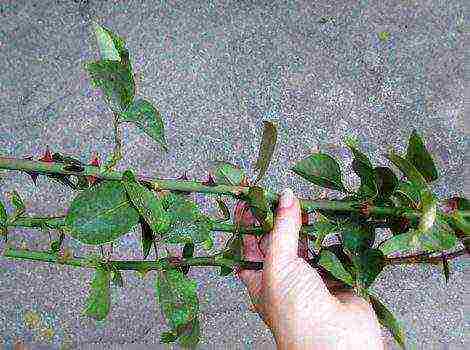Content
 Passion fruit is an unusual plant that came to our latitudes from the hot humid tropics. Nevertheless, this exotic fruit has taken root in our country, so many gardeners are happy to start growing it at home. Further, about the features of growing passion fruit (seeds, from a stone, cuttings), as well as about caring for the plant at home (photos and instructions are attached).
Passion fruit is an unusual plant that came to our latitudes from the hot humid tropics. Nevertheless, this exotic fruit has taken root in our country, so many gardeners are happy to start growing it at home. Further, about the features of growing passion fruit (seeds, from a stone, cuttings), as well as about caring for the plant at home (photos and instructions are attached).
The scheme of growing passionfruit from seeds, seeds, cuttings
Passion fruit (edible passionflower) is a climbing plant from the Passionaceae family. This is a magnificent fruit known all over the world, which is very much loved due to its delicate sweet pulp, used as a dessert or as a base for preparing drinks.
At home, this plant is grown not so much for fruit as for decorating the house, because passion fruit blooms exceptionally beautifully, and it is worth the effort spent on it.
Since we are talking about growing passionfruit at home, the plant will happily "live" to adulthood when grown in any of the following ways.

Ripe passionfruit
Seeds. To really achieve a worthwhile result, you need to use only fresh seeds: dry ones may not even sprout. Therefore, a couple of days before the planned passion fruit planting, buy fresh ripe fruit from the store and select a few seeds. Spread them out on a cloth and rub gently until the juice bags open. After that, you should rinse the seeds and dry them. Then wash and dry again (never in the sun).
Now you can start preparing the container for growing passion fruit: it should not be very deep. Pour the prepared soil mixture there (garden soil, sand, compost in a ratio of 1: 1: 1). Make small furrows in the soil, keeping a distance of about 5 cm between them. Lower the seeds into the furrows at a distance of about 1 cm from each other and sprinkle them with a thin layer of soil. Water the seedlings and leave in a warm place. Moisten the soil periodically. When the shoots have reached a height of about 20 cm, you can transplant to a permanent place.
Cuttings. This growing method is very simple and can give the desired result in most cases. So, first of all, prepare a deep growing container. The soil mixture for growing cuttings should consist of fine-grained sand and fertile soil (3: 1). The soil and sand should be thoroughly mixed so that the growing mixture is uniform.
Advice. Do not worry about using such a specific soil mixture (after all, it practically does not retain moisture). The fact is that passionfruit cuttings at the time of planting do not have roots and the main goal at the first stage of cultivation is considered to strengthen the aerial part of the plant, respectively, it should receive the lion's share of moisture.
The stalk must be chosen correctly: only young shoots with at least 3 buds are cut off (the cut is done obliquely above the lower bud). The soil is prepared in the same way as for growing by seed. The stalk should be planted in a container immediately after it has been cut. The cuttings must be kept in a humid environment.You can create such an environment with the help of an impromptu greenhouse: you can make it from a box-shaped frame covered with plastic film.
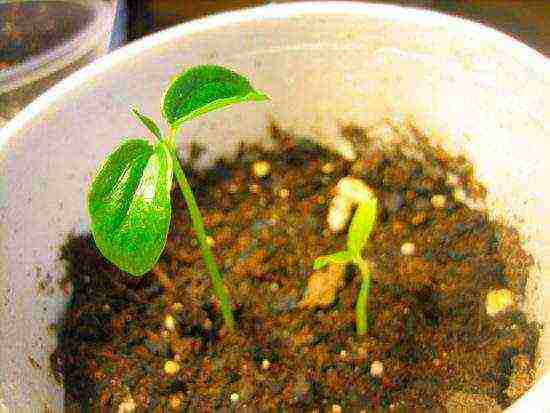
Young sprout of passionfruit
The created camera is moved to a sunny place with high humidity. The cuttings should take root in just a couple of weeks. After that, you can transplant to a permanent place.
From the bone... This method is quite exotic and requires a lot of effort (at least, patience will probably be required). The fruit is thoroughly cleaned, the bone is freed from the pulp, after which it is thoroughly dried. The seed is not planted very deeply into the soil. The seedling is watered. The container with the planted bone should be in a warm place with high air humidity. Thus, the passion fruit will provide optimal conditions for the emergence of the sprout.
The intricacies of caring for passion fruit at home
Passion fruit is a rather capricious plant, which means that it will need careful and serious care. The main activities for the care of passion fruit:
- Watering. Since passionfruit is a resident of a humid climate, it must be watered thoroughly and quite often. Remember: the soil in which the fruit grows should never completely dry out. If the air humidity in your home is not very high, be sure to water the plant at least once a week.
- Top dressing. Passion fruit is very fond of "eating", so feeding should be generous and regular. Fertilization should be started in the spring, then added once in the summer, and for the last time in early autumn. Slow-acting organics with a low nitrogen content (for example, granulated chicken droppings) are best suited for feeding.

Flowering passionfruit
- Support creation. Since the passionfruit is a liana-like plant, it will need strong support to guide its movement. Passion fruit always strives upward, and if given such an opportunity, it will turn into a strong healthy plant, which, moreover, gives fruits. When the first antennae appear on the plant, they should be carefully tied with a thin rope and tied to a support. It is advisable to place lateral branches in the direction opposite to the main stem.
- Pruning. Passion fruit must be cut off without fail, and it is advisable to do this no more often than once every 2 years, in the spring. First of all, all old and weak shoots are removed. Never cut off an old branch at the base - leave a few buds as a new shoot can grow out of it.
Advice. Passion fruit pruning should be carried out exclusively before flowering: if you are late with the procedure and carry it out during the flowering period, you can greatly weaken the plant and reduce the yield.
That's all the subtleties you need to know about growing passionfruit at home. Good luck!
Planting passionfruit cuttings: video
Passion fruit is not very whimsical and if you follow some rules for caring for it, you can get your own harvest of fruits on your windowsill.

Passion fruit varieties
Before planting passion fruit, you need to decide on its type: growing conditions for each of them are different.
The most unpretentious variety is purple passion fruit. It produces sweet fruits, while less demanding on heat than, for example, yellow passionfruit with sour fruits. There are also hybrids of these two varieties, they are more resistant to weather conditions and parasites.
Passion fruit is grown from seeds. You can buy them in a specialty store or get them from the fruit of a vine. You can also grow a liana at home from a vine that needs to be rooted, but usually getting a stalk of a plant for planting is quite difficult.
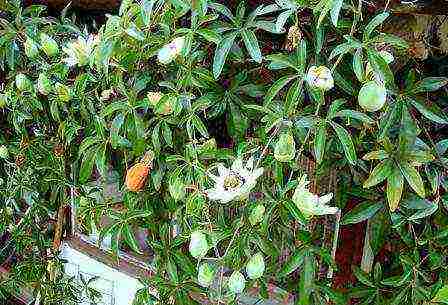
In what conditions to grow passion fruit
Passion fruit is very fond of heat, thanks to which it grows quickly, while clinging to almost any support. For this reason, for the successful cultivation of vines, it is necessary to organize a suspension system.The best way is to make it in the form of a grid. In the process of passion fruit growth, its vine and leaves grow very quickly, therefore, it is worthwhile to initially organize a very strong base for the plant. Additional garters for passion fruit are not needed, as it itself acquires strong tendrils for fastening, like in grapes.
Read also: How to grow mango from seed? SIMPLY!
The seed from the fruit must be removed just before planting. It is desirable that the fruit is overripe, its surface is wrinkled. The seeds of such fruits are in an active phase, therefore they will sprout quickly - in about 2-2.5 weeks.
If these are purchased seeds, the seedlings will appear in about a month, since these seeds are “dormant” and dried. But in this case, you can be sure that the seeds are ready for planting, there is information about the variety and the rules for caring for the plant.
Advice
Growing vines at home should take place in a mixture of turf and peat. Sprinkle the seeds with a small layer of soil. For planting, you will need several seeds, each of which should be placed in a separate pot. Thus, it will be possible to choose the strongest plant and safely transplant the grown passion fruit.
Passion fruit is unpretentious in choosing soil for growing at home, so you can plant it even in the ground from the nearest forest. Since there is no inflow of natural nutrients in greenhouses, the plant needs to be fertilized with organic matter. For a uniform supply of substances necessary for growth, compost must be periodically added to the topsoil.
When growing a tropical plant, special attention will have to be paid to high-quality watering:
- Although passionfruit loves moist soil, you cannot overmoisten it, let alone let the water stagnate.
- You need to water the vine often, as soon as the soil surface dries up.
- The portions of water should be small and drainage should work well.
- In winter, the plant only needs to be watered once a week. The temperature around it must always be positive.

When passionfruit grows in its natural environment, it has to go through many barriers to get to light. Growing at home allows her to fill both shady and sunny areas of the room. The pot with the plant should be placed in a shady, cool place. In the spring (in March), you can cut the vine, it will not harm it.
If the cultivation of liana takes place in ideal home conditions, it can bear fruit as early as a year after germination. In the wild, this happens after about 6 months. The plant begins to bear fruit so quickly, because the life of the vine is short - only about 6 years. Within 3 years after the plant has emerged, its yield is greatly reduced compared to the first year. For this reason, those who love this plant plant a new specimen every year to get a good harvest of passion fruit every year.
Share this important information with your friends on social networks!
READ ALSO
 Passion fruit only seems like an exotic plant, but if certain conditions are met, this beautiful plant will not only grow well, but will also delight with small fruits. Passion fruit is considered an unpretentious plant that can be grown at home or in winter greenhouses.
Passion fruit only seems like an exotic plant, but if certain conditions are met, this beautiful plant will not only grow well, but will also delight with small fruits. Passion fruit is considered an unpretentious plant that can be grown at home or in winter greenhouses.
The origin and varieties of passion fruit
The passion fruit is native to the mountainous woodlands of South and Central America, and can also be found in parts of Australia and Asia.
Passion fruit belongs to the genus passionflower. Therefore, the second name for passion fruit is passionflower. More than 2 hundred species of lianas belong to this genus.
For home cultivation, purple passion fruit is most suitable. It has delicious sweet fruits, is less heat demanding and much easier to care for. But the yellow passion fruit has difficult conditions of detention, and its fruits are quite sour.Therefore, such passion fruit is unlikely to please flower growers.
Also, under indoor conditions, blue and winged passionflower are grown. These varieties have a decorative appearance, large bright green leaves, which have an oval or finger-dissected shape with a glossy surface.
Some of the species can be planted outdoors.
The plant is a long lash that can grow rapidly. Most of all, this plant is valued for its large flowers, their diameter can reach 12 centimeters. Moreover, the flowers are not only beautiful, but also smell good. There are two glands in the middle of the flower. After flowering, an oval fruit forms in the middle. The fruits are yellow or reddish in color, and the flesh has a soft, delicate texture.
Passion fruit - growing at home
Passion fruit at home will require a lot of sunlight. Therefore, it should be located in sunny places, east and south windows will do.
Planting passionfruit
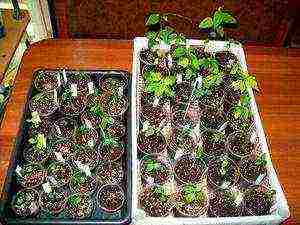 After the plant is purchased, it should be transplanted. The soil in which the plant is planted under industrial conditions is not quite suitable for growing this plant at home. Therefore, immediately after purchase, it is worth replacing the soil with a more suitable one. You can use the same pot to start., but as the plant grows, the pot gradually increases in diameter.
After the plant is purchased, it should be transplanted. The soil in which the plant is planted under industrial conditions is not quite suitable for growing this plant at home. Therefore, immediately after purchase, it is worth replacing the soil with a more suitable one. You can use the same pot to start., but as the plant grows, the pot gradually increases in diameter.
The soil mixture can be used ready-made; it is sold in specialized stores. It is necessary to choose mixtures with a high content of peat. But you can build the soil yourself. For this they take garden, leafy soil and peat. All ingredients must be taken in equal proportions. A little sand is also added to the mixture.
The pot is chosen in the usual shape. There should be holes in the bottom of the pot, if they are not provided, then you need to make them yourself. In a plastic pot, it is easy to make holes with a hot nail.
Drainage is laid at the bottom of the pot with a layer of 2-3 centimeters. Expanded clay, small stones and other materials can be used as drainage. Such drainage will not allow excess moisture to remain at the plant roots and they will not rot.
Before planting, the plant is well watered so that the roots are not injured too much. The plant is carefully removed from the old pot, the roots must be protected with a clod of earth. The sprout is transplanted into a new pot and carefully covered with earth. The surface of the ground must remain at the same level. The plant is well watered.
Passion fruit propagation
Most often, passion fruit is propagated by seeds.
You can get seeds in different ways:
- The seeds are purchased from the store. The fresher the seeds, the higher the germination rate. When purchasing, you need to take into account the period of harvesting seeds.
- They are taken out of the ripe fruit on their own.
Features of growing from seeds
 If the seeds are extracted from the fruit, then rinse them thoroughly with water. When washing is done poorly, a thin layer of pulp remains on the seeds, which will prevent the germination of the sprout.
If the seeds are extracted from the fruit, then rinse them thoroughly with water. When washing is done poorly, a thin layer of pulp remains on the seeds, which will prevent the germination of the sprout.
Wet seeds dry a little. Seeds are planted in spring, this is the most favorable period for germination and growth of young seedlings.
First you need to prepare the correct soil composition. The soil should be nutritious but light. You can mix two parts of sod land, one part of humus and one part of sand. Suitable for growing pots with a diameter of 8 centimeters. You can plant 2-3 seeds in one pot.
They pour earth into the pots, tamp and watered a little. Seeds are laid out on moist soil, sprinkled with soil 1.5 centimeters thick and moistened again with a spray bottle.
The pots are placed in a room with good lighting and an air temperature of 20-25 degrees. To create a comfortable microclimate, the pots are covered with foil or glass.
Further care consists in regular airing and watering.
Seedlings appear 20-30 days after planting. It is then that the film is removed.
After four true leaves appear on the plant, they are transplanted into pots with a diameter of about 40 centimeters. The soil is used the sameas when planting seeds.
Some experts recommend planting two young plants in each pot. The young plant must be placed so that the stem is in the sun, but the pot is in the shade. At the same time, the plant should not be placed in a draft.
The first fruits are tied on the plant after a year.
Passion flower care
Plant care has some rules:
 First of all, passionflower needs to be properly tied up. There are special lattices on sale that are designed to tie up climbing plants. They can be made of thin metal or plastic. You can simply pull on the strings and sprout along them as you grow.
First of all, passionflower needs to be properly tied up. There are special lattices on sale that are designed to tie up climbing plants. They can be made of thin metal or plastic. You can simply pull on the strings and sprout along them as you grow.- Watering is carried out as soon as the soil surface dries up. But you need to be careful with watering, excess moisture can lead to root rot and plant disease.
- Fertilizers are applied only during intensive growth, that is, in the summer. At this time, the plants are fertilized once every 10 days. An excellent top dressing is a liquid complex fertilizer intended for tomatoes.
- During flowering, the plant must be manually pollinated. Pollination will be more effective if the air humidity does not exceed 70%. Pollination is started in the morning or closer to dinner. The process of pollination itself is not difficult, it is necessary to collect pollen from one flower with a brush and transfer it to another flower. All flowers are processed in this way.
Growing passionfruit at home - a fairly simple lesson, you just need to properly organize her place, competent and timely care. And if you choose the right variety, then you can harvest a small crop directly from the windowsill.
> Passion fruit at home
The passionfruit plant (passionflower) is a guest from the hot tropical humid forests, which, as it turned out, was able to perfectly settle with us. However, in order to grow an exotic culture at home, you need to have an idea of some of the nuances.
Description and types of plants
Passion fruit is an evergreen plant whose stems are covered with green foliage that resembles lianas. Passionflower has an unusual shape and amazingly beautiful flowers, shimmering with various shades of the rainbow.

You can plant passion fruit not only for beauty. Its delicious juicy fruits will leave few people indifferent.
Any kind of exotic culture can be grown at home. But for these purposes, blue or winged passionflower is best suited.
Purple passionfruit is an unpretentious variety. She does not need as much warmth as representatives of other species, but her fruits are juicy and sweet. In addition, varieties such as sweet granadilla and giant granadilla are popular in our country. Laurel-leaved passionflower and banana passionflower are no less in demand.
How does passion fruit grow?
Passion fruit grows excellently at home, but only for this it is necessary to create special conditions under which the tropical culture will feel comfortable.
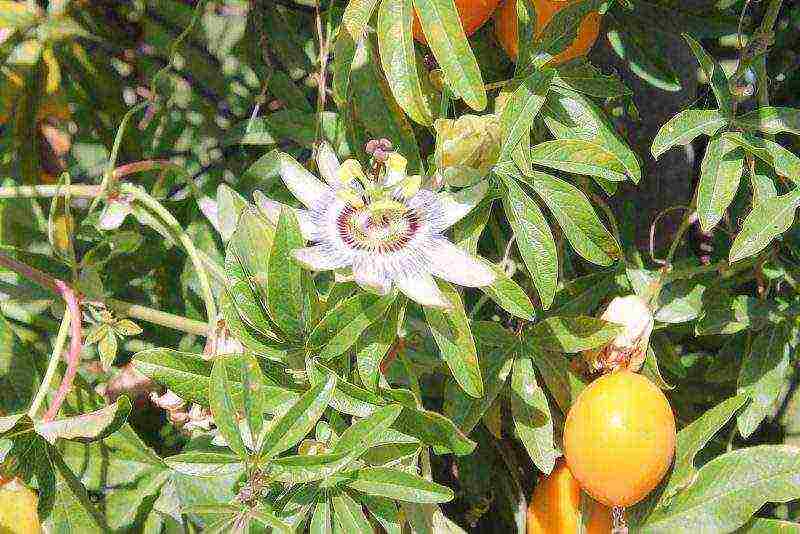
It is very important to protect the plant from the cold. If passionfruit leaves become soft, turn yellow or have fallen off, then passionflower lacks warmth or moisture.
When growing passionflower in a comfortable environment, a year after planting it can begin to bear fruit. The plant lives for about 6 years.
How to grow a plant from seeds, seeds, cuttings?
Growing passionfruit can be done in different ways.
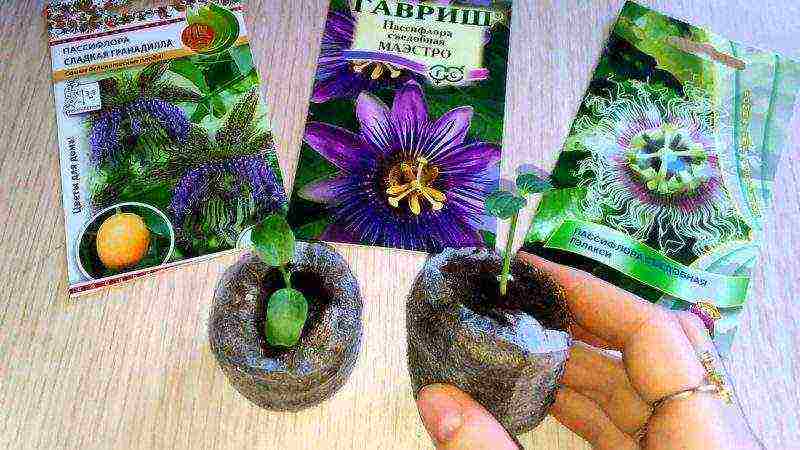
- From the bone. The bone removed from the fruit is freed from the pulp and dried thoroughly. It is planted in the ground shallowly. The seedling pot is placed in a warm place.It is important that the humidity is high. Systematic watering is provided.
- Seeds. Only fresh seeds will do. 2-3 days before planting, a fresh passionfruit is bought, from which the seeds are extracted. They should be placed on a cloth and rubbed gently until the juice bags open. Then the seeds are washed and dried (they cannot be put in the sun). Rinsing and drying must be repeated once more. A mixture is poured into a shallow container, which includes garden soil, sand and compost in equal proportions. Small grooves are made in the ground, in which the seeds are laid out. Top covered with a thin layer of soil. The seedlings are watered and placed in a warm corner. When the sprouts reach 20 cm, it is recommended to transplant them to a place that will become permanent.
- Cuttings. In the container prepared for planting, soil is poured, prepared according to the principle similar to that for planting by seeds. It is important to choose the right stalk. All young shoots with 3 or more buds are cut obliquely above the lower bud. After cutting, the stalk must be planted immediately. For favorable growth, it is recommended to take care of creating a moist environment. An impromptu greenhouse will do. If everything is done correctly, then after 2 weeks the cuttings will take root. After that, the passion fruit is transplanted to a permanent place.
Caring for passion fruit at home
Exotic liana passion fruit is a capricious plant that needs careful attention. In addition to regular watering, you need to take care of feeding the plant. Since passionflower loves to "eat" very much, it is recommended to feed it often and abundantly. Start feeding in the spring, then again in the summer and again in the fall. Top dressing should be a slow acting organic with a low nitrogen content. A great option is granulated chicken droppings. Fertilizers are not needed in winter.

Important! Particular attention must be paid to high-quality watering.
Despite the exotic guest's special love for humidity, do not overdo it. It is often recommended to organize watering of the vines, but only after the soil surface dries out. In winter, it is enough to organize watering once a week.
When cultivating passionflower in the home, you must regularly spray it from a spray bottle. Lack of moisture will lead to sad consequences in the form of discarded leaves and buds.
The nuances of growing at home
Passion fruit is quite a thermophilic fruit. It grows quickly and begins to cling to any fulcrum. Therefore, you should worry in advance about the organization of the suspension system. The best option is a mesh.

During growth, the vine and leaves of the plant grow rapidly, therefore, you first need to organize a strong base. There is no need to worry about additional garters, as the antennae of the passion fruit themselves are reliable and cling tightly.
In the choice of soil, the plant is unpretentious, so it can be planted even in sod brought from a nearby forest.
Full growth requires bright lighting. Don't worry about shading once again.
Important! Passion fruit grows well in the shade. However, in this case, you should not count on active flowering.
The room should be regularly ventilated, this is very useful for the plant. In summer, she especially needs fresh air, so it is recommended to put the pot with the seedling by an open window or take it out to the balcony.
How to prune and replant correctly?
Pruning
Trim the passion fruit in the spring. It is recommended to do this once every 2 years. First you need to get rid of all old and weak shoots.
Important! You cannot cut off an old branch at the very base. It is imperative to leave several buds, from which a new shoot can grow.
Cutting the passionfruit is only necessary before the flowering period.If you do this at a time when the plant has already bloomed, this will negatively affect it - the exotic guest will weaken, and his yield will significantly decrease.
Transfer
Young plants need to be replanted every spring, mature plants - once every 2-3 years. The new capacity must be larger than the old one. But you should not take too large a pot either, since all the vines' strength in this case will be spent on growing roots and building up green mass, while flowering will noticeably decrease.

Passion fruit is a tropical plant that can be safely grown at home. Subject to all the requirements for the content, an exotic liana will delight gardeners with beautiful flowers and delicious fruits.


